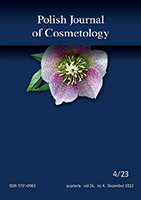search by
Copyright @ Pol J CosmetolBiological activity of tannins and its used in cosmeticsMartyna Naskręt, Paulina Znajdek-Awiżeń, Elżbieta Studzińska-Sroka, Wiesława Bylka Katedra i Zakład Farmakognozji Uniwersytet Medyczny im. Karola Marcinkowskiego w Poznaniu Summary Interest in medicinal plant among cosmetologist still growing mainly due to the biological activity of the plant raw materials including effect on the skin related to the presence of chemical compounds. Tannins are polyphenolic compounds of high molecular mass (500-3000 Da) which are characterized by a common property of forming a fixed connection with proteins. They can be distinguish among hydrolyzing (gallotanins and ellagitanins) and non-hydrolyzing tannins (catechins). Both of them exhibit an astringent, antimicrobial, antioxidant and ant-inflammatory activity. In addition, they facilitate the contraction of blood vessels as well as formation of blood clots and have the ability to inhibit some enzymes, such as hyaluronidase, elastase or tyrosinase. Tannins are used topically in the treatment of skin inflammation and abrasions, skin allergies, burns, frostbite, insect bites, and inflammation of the mucous membrane of mouth, throat, vagina and rectum. Cosmetic preparations containing tannins are recommended especially for oily or combination skin. The compounds are also used as an ingredient of shampoos for dark and greasy hair, sometimes in anti-aging. Key words: tannins, biological activity, application in medicine and cosmetics |




